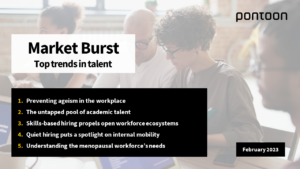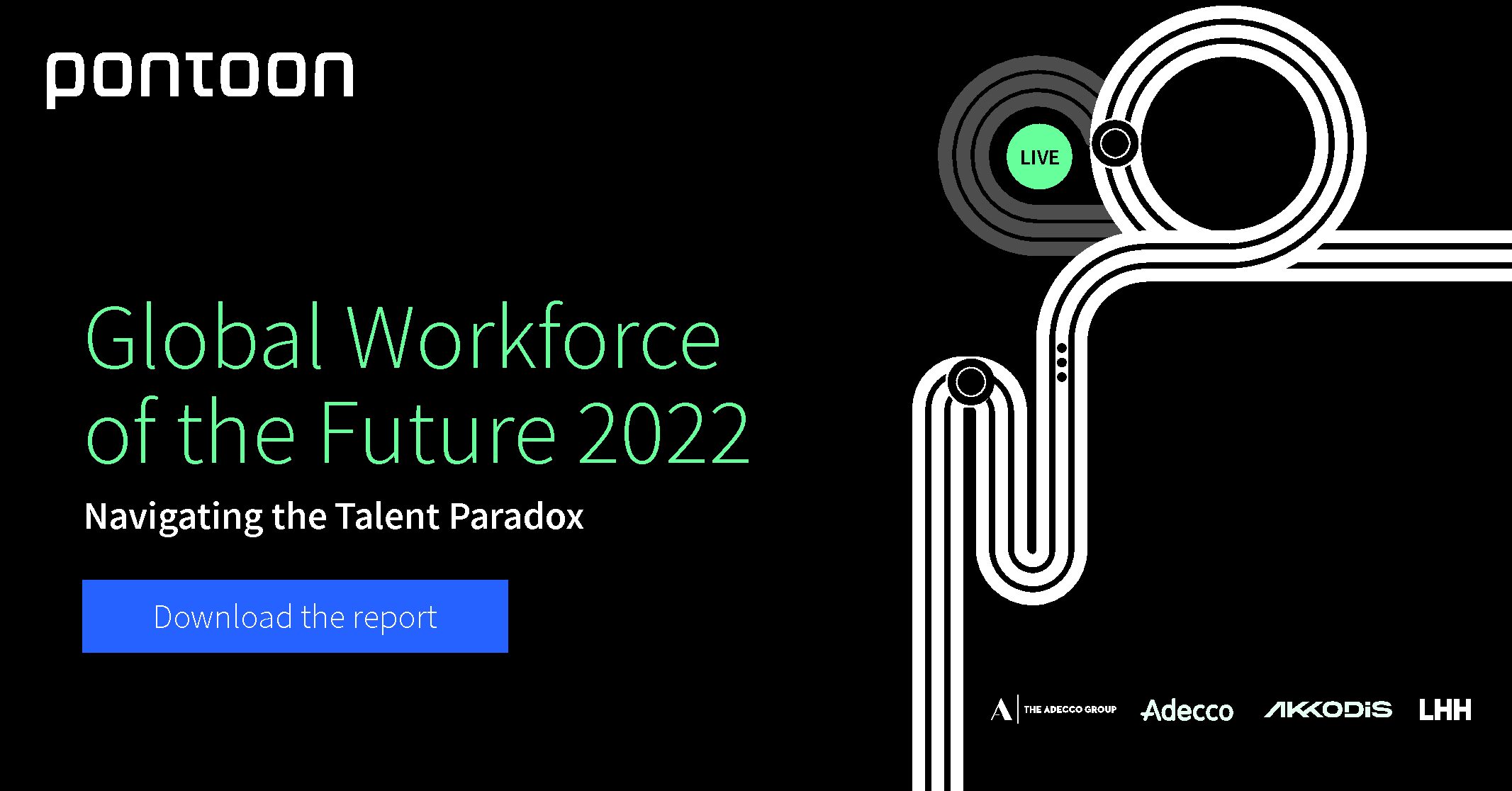Market Burst: February 2023
Read about top trends in the world of work.
In this month’s instalment of our Market Burst, we dive into the trends that continue to drive talent management in the evolving workspace. These include skills-based hiring that propels open workforce ecosystems, quiet hiring that puts a spotlight on internal mobility, and more.
Preventing ageism in the workplace
Across the globe, retirees are re-entering the workforce as inflation and rising costs of living motivate them to seek additional income. In the US, 64% of adults ages 55-64 are professionally active, with many returning from retirement to boost their household budgets and seek a sense of connection and engagement at work.
This revival of the older workforce is expected to continue in 2023 and should motivate companies to re-evaluate their stance and internal policies on preventing workforce ageism. While DE&I efforts related to gender, ethnicity, and sexuality have seen steady growth in importance and effectiveness in recent years, anti-ageism campaigns are lagging behind. In the US, 78% of employees aged 50 or older have reported experiencing or witnessing age-based discrimination at work. In the UK, only 5% of workers believe their organisation is proactively trying to recruit older workers. Studies show that job applicants aged 45 or older are generally perceived less favourably by hiring managers worldwide.
Companies should make strategic efforts to combat this unconscious bias and educate recruiters and hiring managers accordingly. Older candidates offer decades of relevant experience and a congenial professional presence of someone genuinely looking forward to working again. As we move into the digital age, older workers need to keep up with shifts in skill demand. Training initiatives provide opportunities to brush up on competencies they’ll need in this new era of digitisation.
The untapped pool of academic talent
In the UK, three-quarters of academics in research are likely to leave their university jobs. 8 in 10 of the youngest staff admit that pay and conditions are the key factors impacting this decision. Also, more and more people with a doctorate in psychology are exploring alternative careers. The share of US graduates in this field that entered the industry or business sectors has increased by nearly 10% in the last ten years.
The world’s brilliant minds, whose scholarly ambition once drove them to educational heights, are now seeking new opportunities beyond academia. Employers in industries where finding specialised talent is difficult can benefit from the knowledge these experienced professionals possess.
However, the critical thing to remember is that with limited to no experience in the private sector, scholars may not be accessible through traditional talent platforms like LinkedIn. Also, they may find it difficult to present themselves as competitive candidates or even adjust their resumes for non-academic recruiters. To facilitate this talent transition, companies can prepare, publish, and distribute information with guidelines for potential applicants or organise targeted career fairs. Establishing partnerships with major universities and research institutions is also crucial to make academics aware of what career options are available in private firms and how to apply.
Skills-based hiring propels open workforce ecosystems
The workplace continues to evolve, shifting towards a skills-first approach that finally democratises access to job opportunities for everyone. Competencies are transferable across positions, and firms can no longer rely on traditional hiring pathways focused only on specific work experience or education. For example, a cashier has 70% of the skills needed to be a customer service representative, and a driver has 57% of the know-how necessary to transition to a supply chain associate.
The skills-first strategy creates a significantly more robust talent pipeline for employers. LinkedIn reports that 4 in 10 hirers who used their platform in 2022 focused on skills to fill open roles. These firms were 60% more likely to find a successful candidate than organisations that did not rely on skills as part of the hiring process.
It’s a win-win scenario for both job-seekers and employers – so how to make it work?
Some of the biggest brands in the world – including Apple, GM, and EY – started by removing degree-based application requirements, which opened employment access to non-traditional applicants. Creating skills-focused career pathways is an excellent next step, as it enables individuals to pursue vertical and horizontal mobility within the organisation, including dual career ladders. With a skills-first approach, firms can develop a holistic view of the talent they have today and compare that against the competencies needed to achieve long-term business strategy.
Quiet hiring puts a spotlight on internal mobility
After quiet quitting and firing, another “quiet” phenomenon is emerging – quiet hiring. Forecasted to become a major workforce trend in 2023, quiet hiring has to do with organisations acquiring skills without looking for new full-time employees. This can be done, for example, by reassigning current workers to other teams or encouraging them to take on projects that go beyond their primary role. When staffing budgets are either decreasing or remain flat, tapping into the potential of the existing workforce offers a quick fix for filling in the gaps. But not only that – quiet hiring brings the conversation around the pros of internal mobility back to the centre stage.
Experts speculate that the talent mobility component of quiet hiring might be an antidote to the recent challenges with worker retention. Taking on new tasks re-energises employees who feel dissatisfied with their job, helping them reimagine career paths and develop new skills. An opportunity to try out different things and see the daily operations of other departments can open career development possibilities, including potential future promotions. The likelihood of retaining a worker who moved internally throughout three years of employment is 64%, compared to just 45% for a person without any changes in positions or departments. Companies in Australia, UK, and Singapore see the biggest improvement in employee retention among internal movers at the 3-year mark.
Provided that some elements of quiet hiring involve adding responsibilities to workers’ everyday deliverables, rather than them switching roles, employers must set clear expectations and success metrics for documenting performance. Firms need to be transparent about the nature of reassignments – and consider pay increases that would reflect the additional long-term workload. If higher compensation is not possible, benefits like a bonus, flexible hours, or additional time off are a good alternative.
Understanding the menopausal workforce’s needs
The conversation about how menopause affects women’s work globally gained momentum last year, as the global population of menopausal workers is projected to grow by 47 million a year and reach 1.2 billion before 2030.
With societies ageing rapidly, employers need to urgently focus on accommodating the changing needs of their female workforce. Without proper action, firms risk losing valuable talent, as some 10% of women in the UK admit they have quit their jobs because of the discomfort associated with menopause. 8 in 10 say their employer hasn’t trained staff or introduced a relevant absence policy that could have alleviated some of the burdens.
In a recent interview, Helen Tomlinson – Head of Talent Development at Adecco, summarised the vital steps that organisations need to consider to accommodate senior female employees. The starting point is getting the conversation going, for example, as part of informal meetings. These sessions give workers a safe space to discuss how menopause impacts personal relationships and professional performance. The next step is to equip managers with the knowledge and tools necessary to address menopause and how it affects their colleagues’ work life. This can be achieved through workshops with specialists who can advise how to approach female workers and what solutions are available. Company-wide menopause policies are another critical step. These can take many shapes and forms – for example, Bank of Ireland announced in October that it would offer paid leave for women experiencing menopause, while Deloitte included menopause in its global diversity, equity, and inclusion agenda.
Related Post
The Global Workforce of the Future Report is our third annual global workforce study that looks at workers’ perspectives on key topics that impact the future of work.
The findings will ...





